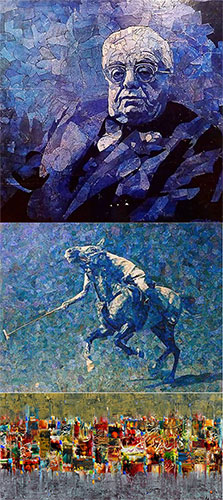Biography
Recreating the Islamic calligraphy with a unique abstract and gestural interpretation, and portraying the
members of Afghan Royal Family and people of elite classes, the Pakistani artist, Ismail Gulgee, is celebrated
as a globally famous Pakistani painter, whose Arabic calligraphy inspired abstract paintings and portrait
paintings are highly admired in Islamic states and the rest of the world as well. He was born on October 25,
1926, in Peshawar, Pakistan. Without receiving any formal education in painting, the self-taught Gulgee
began to paint while studying hydraulics in the US. In 1950, he held his first exhibition in Stockholm, where
he worked briefly as a design engineer. After his higher studies, Gulgee came to Pakistan and held another
solo exhibition in Warsak, near Peshawar, where he was involved in a dam construction project on the Kabul
River. A gifted portraitist, he enjoyed regular state patronage and elite commissions throughout his career.
In 1957, Afghanistan’s King Zahir Shah commissioned Gulgee to paint his portrait, and subsequently invited
him to Kabul to complete another 151 portraits of members of the royal family. Famous as “the court painter
of Pakistan”, Gulgee continued to paint both Pakistani and foreign dignitaries including US presidents
Jimmy Carter and George HW Bush, King Faisal of Saudi Arabia, King Hussein of Jordan and Farah
Pahlavi, Empress of Iran.
Very few people took Gulgee’s artistic inclination seriously. He recalls a meeting with the Aga Khan in the
50s when the spiritual leader of the Ismaili community to which Gulgee belongs told him, “An artist brings
glory to himself, but what your country needs is engineers.” Gulgee who was at that time working in
Stockholm as a design engineer, nevertheless held his first exhibition of paintings in the Swedish city soon
after. He was still concentrating on realistic portraits in oil when he moved to Pakistan to wrok as a builder
of dams in various parts of the country. His first big break and a milestone in Gulgee’s artistic revolution
came at this time when King Zahir Shah of Afghanistan visited Pakistan and was so pleased by a portrait
done by Gulgee that he invited him to Kabul. Stone and marble and lapis lazuli were still some months away
but in Kabul the artist began to produce prolifically and impressively a range of portraits and sketches that
earned him the reputation of being one of Pakistan’s most talented young artists. His portraits were realistic
and strong and his abstracts were not completely bold but the free-flowing style was unmistakably his. And
undoubtedly exceptionally good. In 1959, an exhibition of Gulgee’s work, 151 in all was held in Kabul. Gulgee
is known for his uncanny talent of creating the most faithful portraits of the great personalities of our age in
blue lapis lazuli. Seeing them from a distance you would think that you look at a big photograph in bluishblack,
but at a closer look you discover that the picture is formed from thousands of minute pieces of lapis lazuli that are put together in such a way that they are almost invisibly connected. Thus the picture made of dark blue stones with hundreds of different shades appears as whole as though it were a finely executed painting on canvas.
In 1960, Gulgee received his first extended exposure to abstract
expressionism through an exhibition of American painter Elaine
Hamilton in Karachi. Gulgee adapted action painting's energy and
gesture to a Pakistani context, using virtuoso brushwork to produce
large, free flowing calligraphic abstractions that captured the
mystical dance of Sufi dervishes. In later decades, he embraced
decoration, embellishing his canvases with gold and silver leaf,
pieces of mirror and vibrant constellations of dots. In the late 1960s,
Gulgee began experimenting with sculpture, securing numerous
commissions for large-scale bronze works of Koranic verses and
Islamic symbols, such as the sculpture he executed for Islamabad’s
Shah Faisal mosque in 1986. Though he had a high public profile
across the Muslim world, he exhibited infrequently at home, citing
lack of proper exhibition venues for his large scale work. A rare solo
show at Karachi’s Indus Gallery in 1988 was followed six years later
by an important retrospective at the National Assembly in
Islamabad. Eager to ensure his artistic legacy, in 2000, he
inaugurated the Gulgee Museum near his home in Karachi. His
paintings were bright and full of color, but the paint was put on
with great sensitivity, and paintings vibrate with intense feeling.
Areas sing with luminous, thin color; thick blobs of paint pulsate
with fiberglass tears, the brush swirls strong and free. The total
effect used to be very free, yet considered and well thought out.
They work enormously well, because it was all orchestrated with
great care and concentration. On the evening of 19 December 2007,
Gulgee was found murdered along with his wife Zarin Gulgee and
his maid. He was buried in Karachi on December 20, 2007.

Text Reference:
Excerpts from the article Ismail Gulgee: The Gestural Interpreter of Islamic Calligraphy (book) Gulgee published by Ferozsons in 2000, pg. 23.